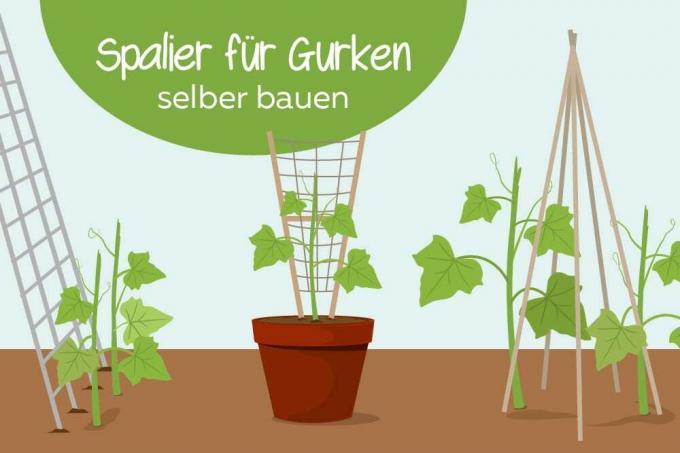
table of contents
- Climbing aids
- Build your own cucumber trellis
- Cucumber support in a greenhouse
- Build climbing aids for outdoor use
- Support for only one cucumber plant
- Instructions for a cone frame
- Build simple wooden lattice
- Inclined grids for large-fruited cucumber varieties
- Stable and versatile trellis
- Build mini trellises for tub cultures
Cucumber plants form long tendrils that spread out on all sides at the ground level. They only strive upwards if they find useful support along the way. But then your leaves are safe from moisture and so are the coveted fruits. The dreaded putrefaction can hardly affect them at lofty heights. But climbing aids do not just sprout out of the ground; the gardener has to provide them specifically. With a little skill, he can even build it cheaply himself.
Climbing aids
Of course, the tendrils of a cucumber plant can and should spread out flat on the ground. The Cucumis sativus will also grow under these circumstances and produce its cucumber fruits. Nevertheless, it makes sense to give her a climbing aid. It offers the following two advantages:
- cucumber leaves dry quickly at a lofty height
- the cucumber plant takes up less space
Dry leaves are important for this crop, as long-term moisture quickly causes it to rot. Leading the cucumber tendrils upwards also creates more space in terms of width. This is a convincing argument, especially with a very limited cultivation area. Harvesting at hand height is a convenience that the climbing aid also offers us.
tip: Stable climbing supports in particular are an acquisition for a long time. They can be cleaned and used again and again for new generations of cucumbers but also for other climbing plants.
What does a suitable trellis look like?
A Cucumis sativus is covered with plenty of fruit in summer. The thin tendrils then eat a lot of weight, and rain pelting down also exerts additional pressure. So that the tendrils do not sink to the ground or even break off, the trellis must provide them with a secure support up to a minimum height of 1 m.
A secure support is the one that the tendrils can hold on to. Smooth or close-meshed materials are not suitable for cucumber plants, they require a rough surface. In addition, nets must not be tightly meshed. For outdoor growing, there is a third factor to consider: the weather. The trellis must withstand rain, sun and wind.
In summary, a suitable support for cucumbers can be characterized as follows:
- stable
- weatherproof
- handy
- sufficiently high (1 to 2 m)
Build your own cucumber trellis
A trellis can be bought ready-made in the garden center. It's convenient, but it also costs money. Anyone who tends a garden knows how quickly, year after year, a nice sum is left in such centers for all sorts of useful and useless things. Does the purchase really have to be, or is there another way?
A cucumber trellis is not a structural masterpiece, even a skilled hobby gardener can do it. The ingredients are always the same: a few ideas, suitable material, suitable tools and a little time. Which material is needed, however, depends directly on where the cucumber plants are grown. There are usually three options available for their cultivation, all of which require a slightly different solution.
- Cultivation in the greenhouse
- Outdoor cultivation
- Cultivation in a bucket
Cucumber support in a greenhouse
In a greenhouse, the cultivation area is tight, every square centimeter is used. There is hardly any space left for space-filling constructions. Doesn't have to be either! Because a climbing aid for cucumbers can be done in a greenhouse with just a few tools, without being bothersome. You need:
- Ropes made of bast or rough plastic
- Pegs for fastening
How to build a cucumber support for the greenhouse:
- Anchor the ropes with the pegs firmly in the ground.
- Tension the ropes up tightly and attach the ends to the roof structure of the greenhouse.
This climbing aid can be removed again at any time, but can also be expanded with a few additional ropes if necessary.
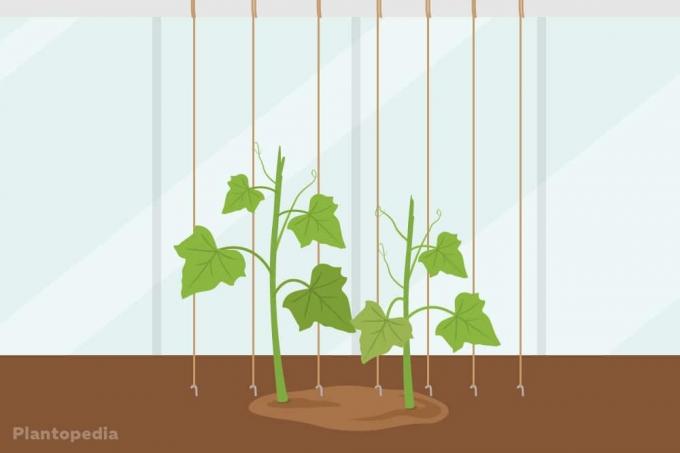
tip: If you have plenty of space in the greenhouse, you can also set up some of the outdoor climbing aids presented below in it.
Build climbing aids for outdoor use
More ideas can be implemented in the open bed than in a small greenhouse. The first decision is whether to build a firmly anchored trellis or a “mobile” climbing aid. Firmly anchored structures offer more stability and are durable, and sometimes more expensive. Because of the necessary crop rotation, it should also be suitable for other plants such as sugar snap peas.
A mobile trellis is connected to the ground in such a way that it can be dismantled every year and set up at a new location. The material costs are usually lower, but it is also less stable and shorter-lived than a solid frame. Here it is also important that you choose a place that is sheltered from the wind. Several tall cucumbers quickly form a "green sail" with their leaves, which intensifies the effect of the wind.
Support for only one cucumber plant
A climbing aid for one single cucumber plant is built quickly. You need a high stick for this, which should also be easy to grip and not too thick. Untreated wooden sticks and bamboo sticks work well.
- Do not wait for the plant to form long tendrils. Set up the climbing aid when sowing or at the latest when the cucumber begins to develop tendrils.
- Find a suitable place to set it up, about 15 cm from the root base.
- Drive the stick at least 20 cm deep into the ground so that it can withstand windy weather.
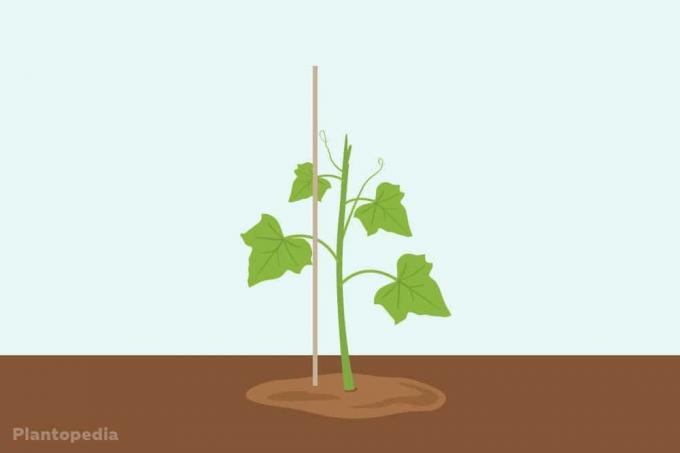
tip: Give the cucumbers a hand by wrapping their tendrils around the stick a few times at the beginning. You can then continue on your own way up.
Instructions for a cone frame
Several bamboo poles or wooden sticks can be combined to form a climbing aid for several cucumbers. To do this, they are inserted deeply and in a circular manner into the earth. The diameter of the circle should be at least 60 cm. The upper ends are brought together so that they can be easily tied together. The finished form resembles a cone. Around it, several cucumbers can climb up it.
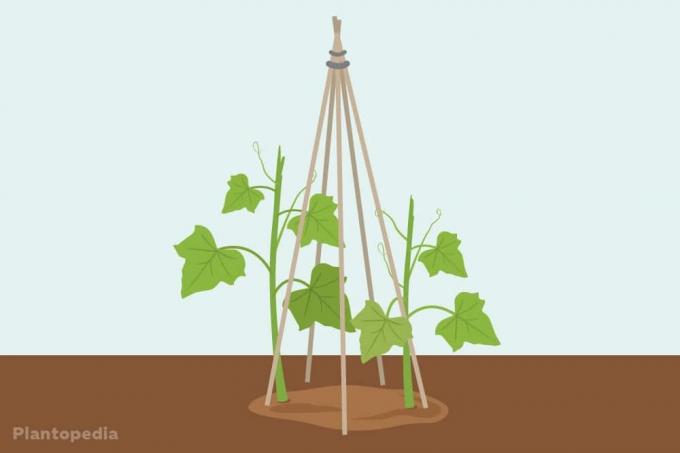
Build simple wooden lattice
A simple wooden lattice consists of a sturdy wooden frame in which strings are stretched like a lattice. For this you need the following materials:
- two narrow and about 2 m long wooden slats for the vertical sides of the frame
- two narrow and about 1.5 m long wooden slats for the horizontal sides of the frame
- a long cord for tensioning
- alternatively a large-meshed network
- Possibly. suitable fastening material
This is how it works:
- Screw the four slats together to form a frame. The vertical sides protrude about 50 cm on one side of the frame
- Fasten the net inside the frame or stretch the rope like a net.
- Insert the protruding ends of the frame deep into the earth.
- You can also attach such a grid - with spacers - to a wall.
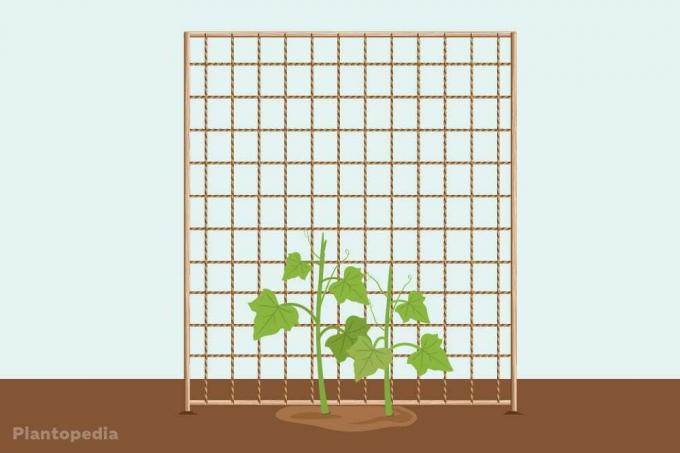
Inclined grids for large-fruited cucumber varieties
Large-fruited cucumber plants need a very stable trellis. Ideally this is inclined at an angle. You can also easily build such a scaffolding yourself. For this you need two welded wire mesh or two wire grids with a large mesh width.
- Put the two grids in the ground. Parallel to each other and at a distance that is 1.5 times their height.
- Lean the two grids against each other like a tent
- Connect the top ends with sturdy wire.
The cucumbers are planted from the outside, climb the tent walls and let the fruit hang through the meshes inside.
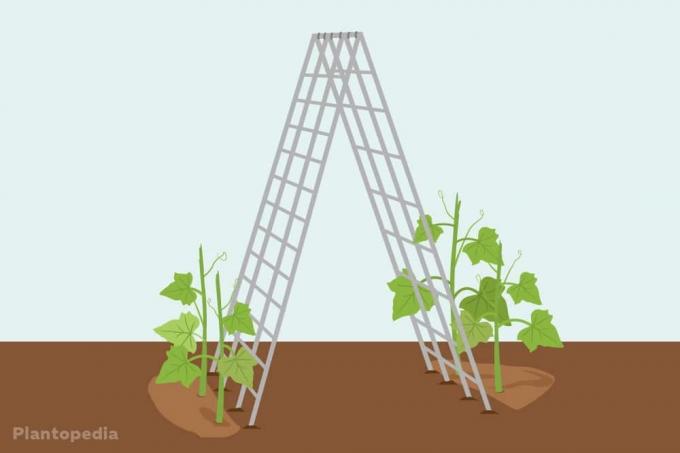
tip: You can also just put a reinforcement mat at an angle, but then you need suitable supports to hold it in an inclined position. Wooden posts or large plant stones, for example.
Stable and versatile trellis
The cucumber is not the only vegetable that a trellis could use. Also snow peas, runner beans, climbing nasturtiums and the like. a. gratefully accept their help. In a large garden with many varieties of plants, it is worth installing a solid trellis. You need at least two thick wooden posts with a height of at least 2 m as load-bearing elements.
- Drive a wooden post about 50 cm into the ground. If this is difficult, you can dig a deep hole beforehand and dig the post in it and, if necessary, also set in concrete.
- Dig in the next stake. The distance to the first post should be about 1 m.
- You can set up additional posts for a wider scaffold.
- Now stretch a 10 x 10 mm net and attach it to the posts. It should be made of non-slip material.
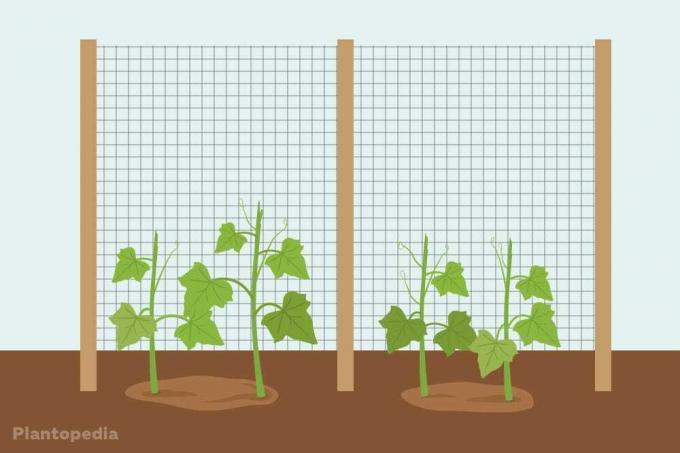
Build mini trellises for tub cultures
A large bucket is also ideal for harvesting a Cucumis sativus on the balcony. If the pot is free and there is no support nearby, you can build one yourself. Below are the instructions:
- Insert two large and sturdy bamboo sticks into the bucket in a V-shape.
- Stretch a large-meshed rope net between the bars.
- Fasten the net in several places with the bamboo poles.
- You can attach one or two more, slightly shorter, bamboo sticks halfway up and across. This gives the construction more stability.

Of course, you can also just stick a single stick in the pot as a climbing aid. But the construction described above gives the cucumber more space to spread out its leaves. A few side shoots can also grow on it and form delicious cucumbers.



